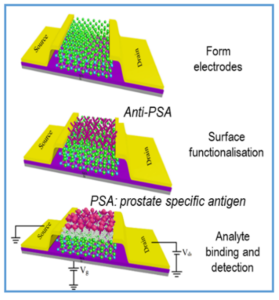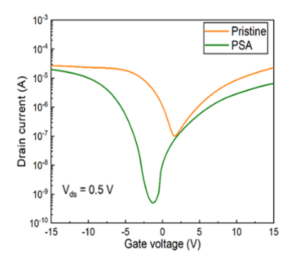The Challenge
Using current technologies, screening of lethal diseases such as cancer is painful (uses body tissue), time consuming and requires infrastructure only accessible to specialist trained personnel at big hospitals or testing facilities.
Easy-to-operate, low-cost and fast-sensing of disease markers, directly in human blood, will enable extension of medical screening and monitoring facilities to populations in remote areas with no access to medical facilities.
The Solution

The new device takes the form of a classic FET transistor, with two electrodes either side of a substrate that has been ‘functionalized’ with antibodies to respond to a particular protein or disease marker (eg, for prostate cancer)
Our ability to synthesise material with the capability to interact with matter at a molecular level, and convert that information into measurable electronic properties such as electrical current, can be used to make electronic sensors for disease markers.
Such sensors do not need specialist expertise to operate, and are very fast.
Key Benefits
- Cheap, energy-efficient, fast detection (a few minutes)
- Does not need infrastructure or a trained specialist to use: Can be used for disease monitoring and screening in remote areas with no medical facilities available.
Development Stage
- Proof of concept demonstrated. Seeking strategic partners.
- We are looking at a Linkage grant to take our devices from TRL 3/4 to TRL 7/8.
Brief Description & Differentiation

Analysis of electrical current flow versus applied gate voltage quickly reveals presence of the target disease marker
We operate our sensors in the field-effect transistor (FET) configuration. We grow our ‘sensing material’ on a substrate and form two electrodes or electrical contacts to measure currents. The surface of our sensing material is ‘functionalized’ with anti-bodies of the protein/disease markers we want to detect. When we expose the FETs to human blood, if the sample contains the disease markers, they selectively bind to the anti-bodies on the surface of the FETs. This binding changes the currents flowing in the FET.
- Do not require any infrastructure
- Can be read-out by anyone – do not require a specialist operator
- Cheap
- Very low limit of detection (~femtogram/mL)
- Fast response – 5-20 mins
- Can be used for small molecules
Intellectual Property
- CT/AU2023/050475
Key Publications
- T.P. Nguyen, et. al., (in preparation)
More information
- Contact A/Prof Sudha Mokkapati sudha.mokkapati@monash.edu

